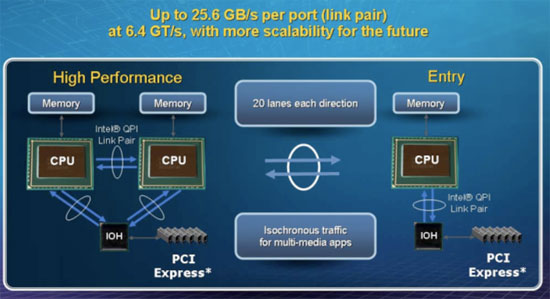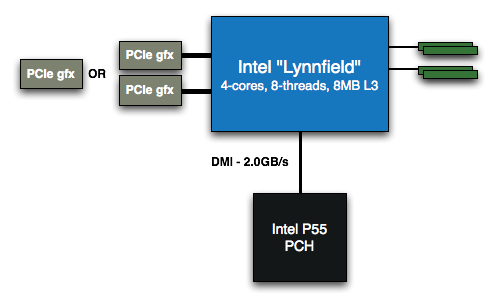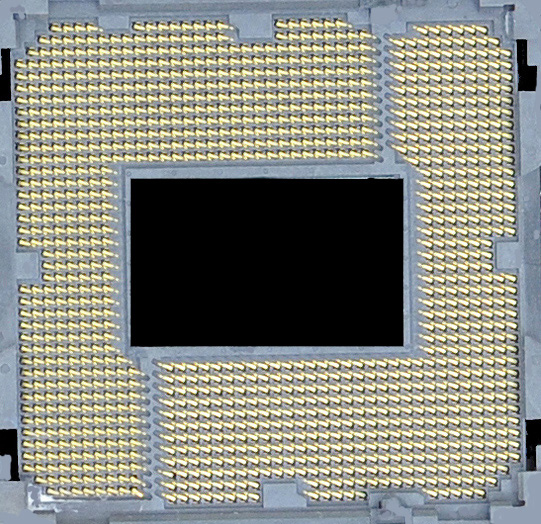The Lynnfield Preview: Rumblings of Revenge
by Anand Lal Shimpi on May 29, 2009 1:00 PM EST- Posted in
- CPUs
Making Nehalem Affordable: LGA-1156
Take the Core i7, shave off one memory controller and replace the high bandwidth QPI link with Intel’s slower DMI and you’ve got the makings of a (more) mainstream Nehalem.
Many have been calling this processor the Core i5 although I’m not quite ready to jump on that bandwagon, so I’ll keep referring to it by its socket (LGA-1156) or codename (Lynnfield).
Intel’s QPI is a very fast bus delivering up to 25.6GB/s of bandwidth. The image below shows you how Intel sees it being useful:

If you’ve got a multi-socket system (e.g. dual processor Xeon workstation, or Skulltrail successor) or if you’ve got a lot of high bandwidth PCIe devices (e.g. multi-GPU or lots of Larrabees) then QPI makes a whole lot of sense. However, if you’ve got a single socket system and aren’t running a lot of high bandwidth PCIe devices then QPI is overkill.
Intel’s DMI is the link used between the X58 chipset and the ICH10 I/O controller, it’s a much more conservative bus capable of delivering 2 - 4GB/s of bandwidth. That’s enough bandwidth for things like SATA and USB but a single PCIe x16 slot can deliver 16GB/s of bandwidth, far too much for Intel’s DMI.
Instead of crippling graphics on its mainstream platform, Intel did the next best thing and integrated 16 PCIe 2.0 lanes onto the die of its mainstream Nehalem part.
What you get looks like this:

A Lynnfield system only need two chips (CPU + PCH) while a Bloomfield system needs three (CPU + IOH + ICH)
The 16 PCIe 2.0 lanes can be configured as one x16 or two x8, allowing you enough bandwidth and very low latency to do things like CrossFire or SLI. Any additional PCIe lanes will branch off of what Intel is now calling the Platform Controller Hub (PCH). The first PCH is Intel’s P55 chipset; all you need is a Lynnfield CPU and the P55 PCH, no additional ICH is necessary as all of that functionality is embedded in the PCH.
The price of Intel’s P55 PCH is also much lower than the X58 chipset, in fact P55 is expected to be price competitive with P45 + ICH10. In other words, we should eventually see P55 boards priced at $100 or less.
Getting rid of QPI and one of the three DDR3 channels knocked down the pin-count of LGA-1366, but adding in 16 PCIe 2.0 lanes brought it back up to 1156 which you can count in the socket below:

I’ve blacked out the motherboard around it and the caps in the middle to protect the innocent.










95 Comments
View All Comments
Seramics - Sunday, May 31, 2009 - link
Why is it that in test that demand intensive multi threading, the lynnfield loses out to bloomfield while in less intensive multithreaded or single threaded test, the lynnfield can equal bloomfield? Could it be that in intensive multithreading processing that work up more than 4 threads (thereby requiring the use of HT for better performance), it is able to use the extra memory bandwith provided by triple channel in the bloomfield platform? Maybe in situation where the software can really demand mutlple threading processing intensively, the bloomfield extra memory bandwith provide an edge. An easy way to test this is increasing the memory bandwith of lynnfield and/or decreasing memory bandwith of bloomfield n see wht happens in intensive multithreaded test. Im suspicious of this. Let me know wht u guys thinks.IntelUser2000 - Sunday, May 31, 2009 - link
The Turbo Modes for revealed for Lynnfield way before even Core i7's release.1 core: +5(+4 for non-HT version)
2 core: +3
4 core: +1
It may or may not be coincidence, but the Turbo speed of the highest clock Lynnfield is equal to the Turbo speed of the highest Core i7. The point is, I think since people will overclock the "enthusiast" i7's anyway, the Turbo doesn't need to be so high.
According to Intel, the benefits will be GREATER on smaller form factors, which means laptops will have even HIGHER increases.
RagingDragon - Sunday, May 31, 2009 - link
Hmmm... I'm not sure how much sense Lynnfield will make in the long term - at the high end you'll have Bloomfield on LGA-1366, and at the low end Clarkdale/Arrandale on LGA-1156. I'm not sure if there's enough room between them for Lynnfield, though I guess it does provide an easy upgrade option for inexpensive OEM systems which need to support Clarkdale.brightstar - Sunday, May 31, 2009 - link
I'll wait and see how this pans out, but as of right now the I5 sounds like the new Celery proc to meJS - Saturday, May 30, 2009 - link
"...to protect the innocent"I guess you really wanted to say "to protect my sources". I'm guessing they are not innocent at all, unless you actually stole the stuff from them. ;o)
mybook4 - Saturday, May 30, 2009 - link
The article mentions that Lynnfield will have a new turbo mode that clocks much higher. I was thinking of reasons why intel might put this feature into the mainstream i5 rather than making the feature exclusive to the i7. Then I remembered that the PCIe controller was integrated into the core.To overclock a multiplier locked i5, you would have to increase the base clock. Not sure, but I believe this would also overclock the PCIe controller (something which may not be as tolerant of overclocking).
This might explain why the new high end turbo mode would be included in the i5. You lose high overclocking potential (which would attract overclockers to i7), but in exchange, the i5 does decent overclocking for you.
pyn - Saturday, May 30, 2009 - link
is it possible that we will see turbo modes similar to lynnfield in gulftown? also, is intel going to release any 8 core / 16 thread nehalem processors targeted towards desktop systems or is the nehalem-ex likely to be the only 8 core nehalem we will see?mmpalmeira - Saturday, May 30, 2009 - link
Why did you use the Lynnfield in a 2.66Ghz configuration with HT on if there wont be models like that in the market?Anand Lal Shimpi - Saturday, May 30, 2009 - link
I did that to show what sort of performance having HT enabled is responsible for. Intel isn't making a 2.13GHz HT enabled Lynnfield either, but I ran those tests because they're interesting to look at :)Take care,
Anand
Drazick - Saturday, May 30, 2009 - link
Will the P55 support USB 3, SATA 3, UEFI?When will we see all those features in the chipsets, which for me, are much more important than the i5 by itself.
What about the new Chiopsets, are they SSD optimized?